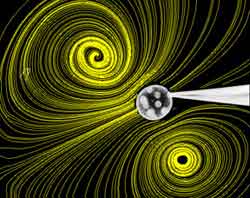Algae’s Protein “Tails” Create Motion – and Aid Munching

<b>Munching in motion</b> <br>The beating flagella of a Volvox colony creates a flow of water around it, visible here through the use of miniscule, illuminated plastic beads. The coordinated beating of flagella creates a nutrient-rich environment for the colony. Image: University of Arizona
In the early online edition of the Proceedings of the National Academy of Sciences, researchers from the University of Arizona and Brown University explain how flagella allow these algae to get the energy they need to multiply and create colonies – the critical secret that allowed them to evolve into multicellular organisms.
“This is the first evidence that flagella not only help organisms move, but can help them feed at a rate that allowed them to evolve to a larger size,” said Thomas Powers, an assistant professor of engineering at Brown who studies microorganisms in motion. “This is a critical piece of information, since understanding how one-celled life forms evolve into many-celled ones is a fundamental question in biology.”
The team studied a group of green algae known as the volvocines, organisms so common they can be found in puddles of rain. Biologists study the group, which runs the gamut from single-celled organisms to teeming colonies, to understand how cells differentiate and multiply. But how did the volvocines jump from solo cells to Volvox, a colony of as many as 50,000 cells?
It’s a puzzler of a question, given the size of a Volvox colony and the laws of physics. Bigger organisms need more energy – a lot more energy – to survive. And Volvox is the largest colony that the volvocines make, a giant ball of flagella-waving body guards protecting a small cluster of reproductive cells. When the radius of the spherical colony increases by a factor of two, the area of the sphere increases by a factor of four. So it follows that the energy demands for Volvox would quadruple, too, as it grows.
Yet microscopic organisms such as volvocines get nutrients through diffusion, a process by which bits of food bump into the cell and pass through the cell membrane. Doubling the radius of the colony doubles – not quadruples – the colony’s food intake rate. So a large organism such as a Volvox colony shouldn’t survive because it would demand more energy than passive feeding could supply, a conundrum that researchers refer to as the “bottleneck problem.”
The research team had a hunch that flagella somehow played a role in bringing in nutrients needed for Volvox to grow and survive. Raymond Goldstein, a professor of physics and applied mathematics at the University of Arizona, gathered together a group of scientists with expertise in physics, mathematics, engineering and biology to work on the problem.
The team created a mathematical model that allowed them to calculate how the flagella created a flow of water around the colony and verified this prediction with experimental measurements. Then they used the model to show that the coordinated beating of the flagella concentrated the nutrients just ahead of the moving colony. The colony plows into this nutrient-rich region and leaves a plume of waste in its wake.
So a Volvox colony doesn’t just passively feed, it actively increases the concentration of nutrients around it using its flagella. Put another way, these tiny protein whips not only acts as legs, but also as arms, gathering in food the colony needs to grow and thrive.
Powers, brought in to help with biomechanical theory, said the surprise in the finding is that the nutrient current created by Volvox was proportional to the surface area of the colony. In other words, Volvox met its rapidly increasing demand for nutrients through flagellar beating, allowing the organism to make the multicellular leap.
“Previous models would have predicted that the nutrient demands of Volvox would outstrip the supply,” Powers said. “But we showed that metabolic supply can, in fact, keep up with metabolic demand. The colony beat the bottleneck problem. Its increasing size is actually an advantage, allowing it to create a faster flow of nutrients.”
The National Science Foundation funded the work.
Media Contact
More Information:
http://www.brown.eduAll latest news from the category: Life Sciences and Chemistry
Articles and reports from the Life Sciences and chemistry area deal with applied and basic research into modern biology, chemistry and human medicine.
Valuable information can be found on a range of life sciences fields including bacteriology, biochemistry, bionics, bioinformatics, biophysics, biotechnology, genetics, geobotany, human biology, marine biology, microbiology, molecular biology, cellular biology, zoology, bioinorganic chemistry, microchemistry and environmental chemistry.
Newest articles

Bringing bio-inspired robots to life
Nebraska researcher Eric Markvicka gets NSF CAREER Award to pursue manufacture of novel materials for soft robotics and stretchable electronics. Engineers are increasingly eager to develop robots that mimic the…

Bella moths use poison to attract mates
Scientists are closer to finding out how. Pyrrolizidine alkaloids are as bitter and toxic as they are hard to pronounce. They’re produced by several different types of plants and are…

AI tool creates ‘synthetic’ images of cells
…for enhanced microscopy analysis. Observing individual cells through microscopes can reveal a range of important cell biological phenomena that frequently play a role in human diseases, but the process of…





















